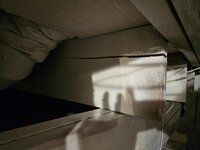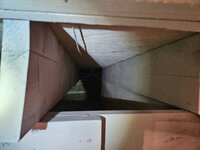Called to look at a house yesterday.
Floor is sagging beneath a newly refinished bathroom (new tile, fixtures, etc. i.e. weight) to the point where the Owner noticed drywall cracks.
Looked at the joists in the crawl space. Many/ most joists in the area have a textbook horizontal shear crack. (Was unable to check joists for level in the tight crawlspace, but the floor above is out.)
Also noticed that blocking has failed in some bays and some joists have twisted.
Running numbers for 40 psf LL and 20 psf DL (tile/ fixtures), the 2x10 joists are overstressed in flexure, but well under allowable shear on this span. I think that's fairly typical with uniform loads on simply supported timber beams.
I'm hesitant to just write the cracks off as checking.
Regardless, I think the solution is to sister some new joists alongside the existing to stiffen the area and arrest future settlement.
That said, from an academic perspective, I'd be interested to hear your thoughts as to why what appear to be shear cracks were observed, but calculation suggests a bending failure and shear should be well under allowable. Are the shear cracks initiating at a defect with much lower shear resistance? Is the slight twist resulting in some minor biaxial bending and I'm seeing a flexural failure in the weak direction? Feels like I'm stretching with those explanations.
Thank you in advance.
Floor is sagging beneath a newly refinished bathroom (new tile, fixtures, etc. i.e. weight) to the point where the Owner noticed drywall cracks.
Looked at the joists in the crawl space. Many/ most joists in the area have a textbook horizontal shear crack. (Was unable to check joists for level in the tight crawlspace, but the floor above is out.)
Also noticed that blocking has failed in some bays and some joists have twisted.
Running numbers for 40 psf LL and 20 psf DL (tile/ fixtures), the 2x10 joists are overstressed in flexure, but well under allowable shear on this span. I think that's fairly typical with uniform loads on simply supported timber beams.
I'm hesitant to just write the cracks off as checking.
Regardless, I think the solution is to sister some new joists alongside the existing to stiffen the area and arrest future settlement.
That said, from an academic perspective, I'd be interested to hear your thoughts as to why what appear to be shear cracks were observed, but calculation suggests a bending failure and shear should be well under allowable. Are the shear cracks initiating at a defect with much lower shear resistance? Is the slight twist resulting in some minor biaxial bending and I'm seeing a flexural failure in the weak direction? Feels like I'm stretching with those explanations.
Thank you in advance.


